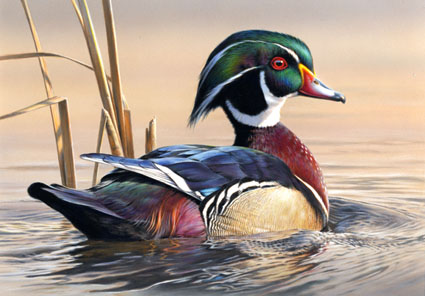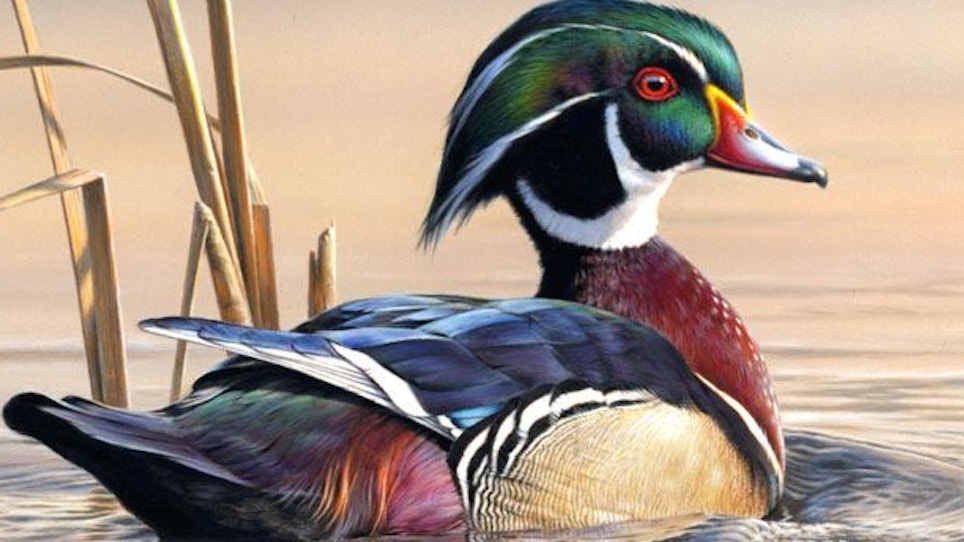 The 2012-13 Federal Duck Stamp by Joseph Hautman |
His art previously appeared on the 1992-1993, 2002-2003 and 2008-2009 Federal Duck Stamps.
Hautman’s acrylic painting of a single wood duck will be made into the 2012-2013 Federal Duck Stamp, which will go on sale in late June 2012. The Service produces the Federal Duck Stamp, which sells for $15 and raises about $25 million each year to provide critical funds for conserving wetlands for the benefit of wildlife and the enjoyment of people.
Of 190 entries in this year’s two-day competition, 32 entries made it through to the final round of judging. Adam Grimm of Burbank, S.D., placed second with his oil painting of a single gadwall. Grimm is also a previous Federal Duck Stamp Contest winner. His art appeared on the 2000-2001 Federal Duck Stamp.
Richard Clifton of Milford, Del., took third place with an acrylic painting of a pair of mallards. Clifton won the 2006 Federal Duck Stamp Contest and his winning art appeared on the 2007-2008 Federal Duck Stamp.
"I wasn’t too nervous to begin with," said Hautman. “But as soon as my brother Bob’s painting went out, I started wanting to win.”
Hautman’s brother Bob has won the Federal Duck Stamp twice previously, in 1996 and 2000. Their brother Jim is the current Federal Duck Stamp artist, having won the 2010 contest and three previous contests. Among them, the three brothers have won the contest 10 times.
"My sincerest congratulations to Joe Hautman on his win, and to all of the artists who entered this year,” said Dan Ashe, the Service’s Director. “The Federal Duck Stamp Contest is a time-honored tradition, and the dedication of wildlife artists to the contest and the stamp’s conservation mission spans generations. This year we saw the oldest contest entrant — a veteran wildlife artist -- as well as the youngest entrant, a young woman of just 19 years old.”
“The stamp itself is widely known as one of this nation’s most successful and effective conservation programs,” said Assistant Director Jerome Ford of the Service’s Migratory Bird Program. “This connection of generations through the traditions of wildlife art and conservation is what makes the Federal Duck Stamp Program so successful.”
Waterfowl hunters age 16 and older are required to purchase and carry the current Migratory Bird Conservation and Hunting Stamp — commonly known as the Duck Stamp. Conservationists, stamp collectors and others must also purchase the stamp in support of habitat conservation.
Ninety-eight percent of the proceeds from the $15 Duck Stamp go to the Migratory Bird Conservation Fund, which supports the purchase of acres of wetlands for inclusion into the National Wildlife Refuge System.
Since 1934, sales of Federal Duck Stamps have helped to purchase nearly six million acres of wildlife habitat for the Refuge System. To date, Duck Stamp funds have been used to acquire habitat at hundreds of refuges in nearly every state. There are 555 national wildlife refuges spread across all 50 states and U.S. territories. A current Duck Stamp may also be used for free admission to any national wildlife refuge open to the public. Refuges offer unparalleled recreational opportunities, including hunting, fishing, bird watching and photography.






